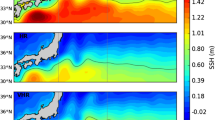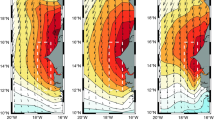Abstract
The Kuroshio Extension (KE) is the inertial meandering jet formed by the convergence of the Kuroshio and Oyashio currents in the Northern Pacific. It is widely mentioned in the literature that the KE variability is bimodal on interannual to decadal time scale. The nature of this low frequency variability (LFV) is still under debate; intrinsic oceanic mechanisms are known to play a fundamental role in the phenomenon but there is also evidence from observations that the KE LFV is connected with changes in broader patterns associated with the Pacific Decadal Oscillation, which is in its turn generated by the dominant decadal mode of the sea level pressure variability in the North Pacific. We investigate the respective contributions of oceanic and atmospheric drivers of the KE variability by taking advantage of the OCCIPUT 1/4° global model dataset: it consists in an ensemble of 50 ocean–sea ice hindcasts performed over the period 1960–2015 (hereafter OCCITENS), and in a one-member 330-year climatological simulation (hereafter OCCICLIM). In this context, OCCITENS simulates both the intrinsic and forced variability, while OCCICLIM simulates the "pure" intrinsic variability. We explore several features of the KE, finding analogies between the OCCICLIM and OCCITENS datasets with autonomous and non-autonomous dynamical systems respectively. This approach aims to apply concepts from the dynamical systems theory on complex and realistic ocean simulations. In this framework, the results suggest that both oceanic and atmospheric drivers control the KE LFV, and that the effect of the low-frequency atmospheric forcing reduces the phase space region explored by the system through synchronization mechanisms. The system’s intrinsic variability can be paced, and therefore clustered over the system’s pullback attractor under the effect of the time dependent forcing.












Similar content being viewed by others
References
Andres M, Park JH, Wimbush M, Zhu XH, Nakamura H, Kim K, Chang KI (2009) Manifestation of the Pacific decadal oscillation in the Kuroshio. Geophys Res Lett 36:L16602
Bessières L, Leroux S, Brankart J-M, Molines J-M, Moine M-P, Bouttier P-A, Penduff T, Terray L, Barnier B, Sérazin G (2017) Development of a probabilistic ocean modelling system based on NEMO 3.5: application at eddying resolution. Geosci Model Dev 10:1091–1106. https://doi.org/10.5194/gmd-10-1091-2017
Brankart J-M, Candille G, Garnier F, Calone C, Melet A, Bouttier P-A, Brasseur P, Verron J (2015) A generic approach to explicit simulation of uncertainty in the NEMO ocean model. Geosci Model Dev 8:1285–1297. https://doi.org/10.5194/gmd-8-1285-
Brodeau L, Barnier B, Penduff T, Treguier A-M, Gulev S (2010) An ERA40-based atmospheric forcing for global ocean circulation models. Ocean Model 31:88–104. https://doi.org/10.1016/j.ocemod.2009.10.005
Ceballos LI, Di Lorenzo E, Hoyos CD, Schneider N, Taguchi B (2009) North Pacific Gyre Oscillation synchronizes climate fluctuations in the eastern and western boundary systems. J Clim 22:5163–5174
Cessi P, Ierley GR, Young WR (1987) A model of the inertial recirculation driven by potential vorticity anomalies. J Phys Oceanogr 17:1640–1652
Chao S-Y (1984) Bimodality of the Kuroshio. J Phys Oceanogr 14:92–103. https://doi.org/10.1175/1520-0485(1984)014,0092:BOTK.2.0.CO;2
Deser C, Alexander MA, Timlin MS (1999) Evidence for a wind-driven intensification of the Kuroshio current extension from the 1970s to the 1980s. J Clim 12:1697–1706
Dewar WK (2003) Nonlinear midlatitude ocean adjustment. J Phys Oceanogr 33:1057–1082. https://doi.org/10.1175/1520-0485(2003)033<1057:NMOA>2.0.CO;2
Dijkstra AH, Ghil M (2005) Low-frequency variability of the large-scale ocean circulation: a dynamical systems approach. Rev Geophys 43:RG002
Drijfhout SS, Hazeleger W (2007) Detecting Atlantic MOC changes in an ensemble of climate change simulations. J Clim 20:1571–1582. https://doi.org/10.1175/JCLI4104.1
Dussin R, Barnier B, Brodeau L, Molines J-M (2016) The making of Drakkar forcing set DFS5, DRAKKAR/MyOcean Report, 01–04-16. LGGE, Grenoble
Fedele G, Bellucci A, Masina S, Pierini S (2021) Decadal variability of the Kuroshio extension: the response of the jet to increased atmospheric resolution in a coupled ocean–atmosphere model. Clim Dyn 56:1227–1249. https://doi.org/10.1007/s00382-020-05528-4
Gehlen M, Berthet S, Séférian R, Ethé C, Penduff T (2020) Quantification of chaotic intrinsic variability of sea-air CO2 fluxes at interannual timescales. Geophys Res Lett. https://doi.org/10.1029/2020GL088304
Gentile V, Pierini S, de Ruggiero P, Pietranera L (2018) Ocean modelling and altimeter data reveal the possible occurrence of intrinsic low-frequency variability of the Kuroshio extension. Ocean Model 131:24–39. https://doi.org/10.1016/j.ocemod.2018.08.006
Gregorio S, Penduff T, Serazin G, Molines J‐M, Barnier B, Hirschi J (2015) Intrinsic variability of the Atlantic meridional overturning circulation at interannual‐to‐multidecadal timescales. J Phys Oceanogr 45:1929–1946. https://doi.org/10.1175/JPO‐D‐14‐0163.1
Hogg AM, Killworth PD, Blundell JR, Dewar WK (2005) Mechanisms of decadal variability of the wind-driven ocean circulation. J Phys Oceanogr 35:512–531
Jiang S, Jin FF, Ghil M (1995) Multiple equilibria, periodic, and aperiodic solutions in a wind-driven, double- gyre, shallow-water model. J Phys Oceanogr 25:764–786
Latif M, Barnett TP (1994) Causes of decadal climate variability over the North Pacific and North America. Science 266:634–637
Latif M, Barnett TP (1996) Decadal climate variability over the North Pacific and North America: dynamics and predictability. J Clim 9:2407–2423
Leroux S, Penduff T, Bessieres L, Molines J, Brankart J, Serazin G, Barnier B, Terray L (2018) Intrinsic and atmospherically forced variability of the AMOC: insights from a large-ensemble ocean hindcast. J Clim 31:11831203
Llovel W, Penduff T, Meyssignac B, Molines J‐M, Terray L, Bessières L, Barnier B (2018) Contributions of atmospheric forcing and chaotic ocean variability to regional sea level trends over 1993–2015. Geophys Res Lett 45:13405–13413. https://doi.org/10.1029/2018GL080838
Mantua NJ, Hare SR (2002) The Pacific decadal oscillation. S R J Oceanogr 58:35. https://doi.org/10.1023/A:1015820616384
Miller AJ, Cayan DR, White WB (1998) A westward- intensified decadal change in the North Pacific thermocline and gyre-scale circulation. J Clim 11:3112–3127
Newman M, Alexander MA, Ault TR, Cobb KM, Deser C, Di Lorenzo E, Mantua NJ, Miller AJ, Minobe S, Nakamura H, Schneider N, Vimont DJ, Phillips AS, Scott JD, Smith CA (2016) The pacific decadal oscillation. Rev J Clim 29:4399–4427. https://doi.org/10.1175/JCLI-D-15-0508.1
Nonaka M, Sasaki H, Taguchi B, Nakamura H (2012) Potential predictability of interannual variability in the Kuroshio extension jet speed in an eddy-resolving OGCM. J Clim 25:3645–3652
Penduff T, Juza M, Brodeau L, Smith GC, Barnier B, Molines J-M, Treguier A-M, Madec G (2010) Impact of global ocean model resolution on sea-level variability with emphasis on interannual time scales. Ocean Sci 6:269–284. https://doi.org/10.5194/os-6-269-2010
Penduff T, Juza M, Barnier B, Zika J, Dewar WK, Treguier A-M, Molines J-M, Audiffren N (2011) Sea level expression of intrinsic and forced ocean variabilities at interannual time scales. J Clim 24:5652–5670
Penduff T, Barnier B, Terray L, Bessières L, Sérazin G, Gregorio S, Brankart J, Moine M, Molines J, Brasseur P (2014) Ensembles of eddying ocean simulations for climate, CLIVAR Exchanges, Special Issue on High Resolution Ocean Climate Modelling, 19
Penduff T, Sérazin G, Leroux S, Close S, Molines J-M, Barnier B, Bessieres L, Terray L, Maze G (2018) Chaotic variability of ocean heat content: climate-relevant features and observational implications. Oceanography. https://doi.org/10.5670/oceanog.2018.210
Pierini S (2006) A Kuroshio extension system model study: decadal chaotic self-sustained oscillations. J Phys Oceanogr 36:1605–1625
Pierini S (2011) Low-frequency variability, coherence resonance and phase selection in a low-order model of the wind-driven ocean circulation. J Phys Oceanogr 41:1585–1604. https://doi.org/10.1175/JPO-D-10-05018.1
Pierini S (2014a) Kuroshio extension bimodality and the North Pacific Oscillation: a case of intrinsic variability paced by external forcing. J Clim 27:448–454
Pierini S (2014b) Ensemble simulations and pullback attractors of a periodically forced double-gyre system. J Phys Oceanogr 44(12):3245–3254. https://doi.org/10.1175/jpo-d-14-0117.1
Pierini S (2015) A comparative analysis of Kuroshio extension indices from a modeling perspective. J Clim 28(14):5873–5881. https://doi.org/10.1175/JCLI-D-15-0023.1
Pierini S (2019) Statistical significance of small ensembles of simulations and detection of the internal climate variability: an excitable ocean system case study. J Stat Phys. https://doi.org/10.1007/s10955-019-02409-x
Pierini S, Dijkstra AH (2009) Low-frequency variability of the Kuroshio extension. Nonlin Processes Geophys 16:665–675
Pierini S, Dijkstra AH, Riccio A (2009) A nonlinear theory of the Kuroshio extension bimodality. J Phys Oceanogr 39:2212–2229
Pierini S, Chekroun MD, Ghil M (2018) The onset of chaos in nonautonomous dissipative dynamical systems: a low-order ocean-model case study. Nonlin Processes Geophys 25:671–692. https://doi.org/10.5194/npg-25-671-2018
Qiu B (2000) Interannual variability of the Kuroshio extension system and its impact on the wintertime SST field. J Phys Oceanogr 30:1486–1502
Qiu B (2001) Kuroshio and Oyashio Currents. Encyclopedia of Ocean Sciences, Academic Press, 1413–1425
Qiu B (2002) The Kuroshio Extension system: Its large-scale variability and role in the midlatitude ocean–atmosphere interaction. J Oceanogr 58:57–75
Qiu B (2003) Kuroshio Extension variability and forcing of the Pacific decadal oscillations: responses and potential feedback. J Phys Oceanogr 33:2465–2482
Qiu B, Chen S (2005) Variability of the Kuroshio extension jet, recirculation gyre and mesoscale eddies on decadal timescales. J Phys Oceanogr 35:2090–2103
Qiu B, Chen S (2010) Eddy-mean flow interaction in the decadally-modulating Kuroshio extension system. Deep-Sea Res II 57:1097–1110. https://doi.org/10.1016/j.dsr2.2008.11.036
Sasaki YN, Minobe S, Schneider N (2013) Decadal response of the Kuroshio extension jet to Rossby waves: observation and thin-jet theory*. J Phys Oceanography 43:442–456. https://doi.org/10.1175/JPO-D-12-096.1
Sérazin G, Jaymond A, Leroux S, Penduff T, Bessières L, Llovel W, Barnier B, Molines J-M, Terray L (2017) A global probabilistic study of the ocean heat content low-frequency variability: atmospheric forcing versus oceanic chaos: forced and chaotic OHC variability. Geophys Res Lett. https://doi.org/10.1002/2017GL073026
Stainforth D, Allen M, Tredger ER, Smith LA (2007) Confidence, uncertainty and decision-support relevance in climate predictions. Phil Trans R Soc 365:2145–2161. https://doi.org/10.1098/rsta.2007.2074
Sushama L, Ghil M, Ide K (2007) Spatio-temporal variability in a mid-latitude ocean basin subject to periodic wind forcing. Atmos Ocean 45(4):227–250. https://doi.org/10.3137/ao.450404
Taylor KE (2001) Summarizing multiple aspects of model performance in a single diagram. J Geophys Res 106:7183–7192. https://doi.org/10.1029/2000JD900719
Taguchi B, Xie S-P, Schneider N, Nonaka M, Sasaki H, Sasai Y (2007) Decadal variability of the Kuroshio extension: observations and an eddy-resolving model hindcast. J Clim 20:2357–2377
Wang Y, Yang X, Hu J (2016) Position variability of the Kuroshio extension sea surface temperature front. J Acta Oceanol Sin 35:30. https://doi.org/10.1007/s13131-016-0909-7
Wyrtki K, Magaard L, Hagar J (1976) Eddy energy in the oceans. J Geophys Res 81:2641–2646
Yang Y, Liang XS (2016) The instabilities and multiscale energetics underlying the mean–interannual–eddy interactions in the Kuroshio extension region. J Phys Oceanogr 46:1477–1494. https://doi.org/10.1175/JPO-D-15-0226.1
Zhang J, Luo DH (2017) Impact of Kuroshio extension dipole mode variability on the North Pacific storm track. Atmos Ocean Sci Lett 10(5):389–396. https://doi.org/10.1080/16742834.2017.1351864
Acknowledgements
The results of this research have been achieved using the PRACE Research Infrastructure resource CURIE based in France at TGCC. This work is a contribution to the OCCIPUT and PIRATE projects. OCCIPUT has been funded by ANR through contract ANR-13-BS06-0007-01. PIRATE is funded by CNES through the Ocean Surface Topography Science Team (OST-ST). The model dataset used for this study is available on request (Thierry.Penduff@cnrs.fr). This work was part of the G.F. PhD in “Science and Management of Climate Change” of the Cà Foscari University of Venice. We acknowledge the CMCC Foundation for having provided computational resources for performing model diagnostics. The authors wish to thank two anonymous reviewers, whose constructive comments helped improve the paper.
Author information
Authors and Affiliations
Corresponding author
Additional information
Publisher's Note
Springer Nature remains neutral with regard to jurisdictional claims in published maps and institutional affiliations.
Rights and permissions
About this article
Cite this article
Fedele, G., Penduff, T., Pierini, S. et al. Interannual to decadal variability of the Kuroshio extension: analyzing an ensemble of global hindcasts from a dynamical system viewpoint. Clim Dyn 57, 975–992 (2021). https://doi.org/10.1007/s00382-021-05751-7
Received:
Accepted:
Published:
Issue Date:
DOI: https://doi.org/10.1007/s00382-021-05751-7




